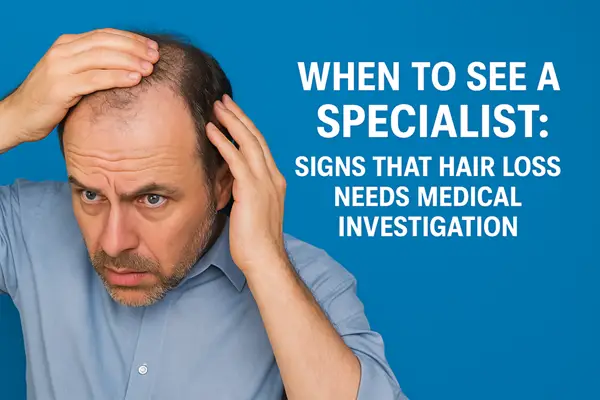Hair loss is one of the most common concerns in both men and women. For some people, it develops slowly over years and is linked to hereditary factors or natural ageing. In those cases, hair thinning is often distressing but not necessarily a warning sign of illness.
Yet not all hair loss should be taken lightly. When the pattern, speed, or associated symptoms are unusual, it may signal an underlying condition that requires medical attention. Recognising these red flags early makes a real difference, as timely investigation and treatment can prevent further losses and sometimes restore healthy growth.
Red flags in hair loss
Gradual thinning on the crown or hairline is often a sign of male or female pattern baldness. But there are several scenarios where seeing a specialist is strongly advised.
- Sudden or rapid shedding: A noticeable increase in hair fall over days or weeks, rather than months or years, may indicate an underlying medical problem.
- Patchy bald spots: Round or irregular bald patches are typical of alopecia areata, an autoimmune condition where the body attacks its own hair follicles.
- Scalp symptoms: Itching, pain, flaking, or redness along with hair loss can point to infection, dermatitis, or inflammatory scalp disease.
- Pain or burning: Hair loss that is accompanied by tenderness, burning, or sores on the scalp is unusual and should be investigated promptly.
- Loss extending beyond the scalp: Thinning of the eyebrows, eyelashes, or body hair often suggests systemic disease rather than local scalp issues.
- Hair loss with systemic symptoms: Fatigue, weight changes, irregular menstrual cycles, or joint pain alongside hair loss can signal hormonal or autoimmune disorders.
These warning signs separate routine thinning from conditions that may need medical tests and targeted treatment.
When common causes may not apply
Androgenetic alopecia (pattern hair loss) is by far the most common type of hair loss. It usually progresses gradually, influenced by family history and hormone sensitivity. For many patients, it starts in the twenties or thirties and becomes more obvious with age.
However, when hair loss occurs rapidly, appears in patches, or develops in people with no family history, it should not be assumed to be genetic. Similarly, temporary shedding after pregnancy, illness, or major stress (known as telogen effluvium) is often self-limiting, but if recovery does not begin within six months, specialist advice is needed.
Diagnostic steps a specialist may take
When you visit a doctor or dermatologist for hair loss, the consultation will usually involve several stages of investigation.
- Medical history: The doctor will ask about family patterns of hair loss, recent stress, diet, medications, and other health problems.
- Physical and scalp examination: The scalp will be checked for signs of inflammation, infection, scarring, or scaling. A dermatoscope may be used for a closer look.
- Hair pull test: Gently tugging a group of hairs to assess how many come out can provide clues about the shedding process.
- Blood tests: These often include thyroid function, iron levels, vitamin D, hormone panels, and autoimmune markers.
- Scalp biopsy: In complex cases, a small skin sample may be taken to examine hair follicles under the microscope.
- Hormonal evaluation: For women, additional tests may be ordered if symptoms suggest conditions such as polycystic ovary syndrome (PCOS).
Together, these steps allow the specialist to distinguish between temporary shedding, pattern baldness, and hair loss caused by disease.
Possible underlying conditions
Hair loss can sometimes be the first visible sign of a more serious health problem. Some of the more common medical causes include:
- Thyroid disease: Both underactive and overactive thyroid function can disrupt the hair cycle, leading to diffuse thinning.
- Iron deficiency anaemia: A lack of iron reduces oxygen supply to hair follicles, resulting in shedding.
- Vitamin deficiencies: Low vitamin D, B12, or zinc can all affect hair health.
- Autoimmune diseases: Alopecia areata, lupus, and other autoimmune disorders may cause patchy or widespread loss.
- Polycystic ovary syndrome (PCOS): Women with PCOS often experience scalp thinning alongside excess facial or body hair.
- Scalp infections: Fungal infections such as ringworm can cause patchy hair loss, redness, and scaling.
- Medication side effects: Drugs including chemotherapy agents, anticoagulants, and some antidepressants may trigger temporary or long-term shedding.
- Chronic illness: Diabetes, kidney disease, and other systemic conditions can also contribute to hair loss.
Identifying and treating these underlying conditions often allows hair growth to recover once the primary issue is controlled.
Why early intervention matters
Delaying medical advice when hair loss is sudden or unusual can reduce treatment options. Inflammatory scalp diseases may cause permanent scarring if untreated, while nutritional or hormonal deficiencies can worsen over time.
Early diagnosis not only protects hair but also highlights hidden health problems that might otherwise go unnoticed. For patients, early reassurance is also valuable. Even when the cause is not serious, professional guidance helps set realistic expectations and reduces anxiety.
Treatment options and support
Treatment will always depend on the underlying cause. Common approaches include:
- Medications: Drugs to regulate hormones, suppress autoimmune reactions, or reduce inflammation.
- Nutritional therapy: Supplements for iron, vitamin D, or other deficiencies identified through testing.
- Antifungal or antimicrobial treatments: For scalp infections causing patchy loss.
- Topical or oral regrowth agents: Medicines designed to stimulate hair follicles.
- Lifestyle adjustments: Stress reduction, improved diet, and better sleep can all support recovery.
TitanPharmax provides access to high-quality, regulated treatments that support patients experiencing hair loss due to medical conditions. When used alongside specialist guidance, these therapies can help restore hair growth and improve confidence.
Practical steps for patients
If you are experiencing hair loss and are unsure whether to see a specialist, consider the following:
- Keep a diary of how quickly hair is being lost
- Note any additional symptoms such as fatigue, irregular cycles, or skin changes
- Take photographs of affected areas to show your doctor progression over time
- Avoid self-prescribing treatments before an accurate diagnosis is made
These simple steps can give specialists more information and lead to a quicker, more accurate treatment plan.
Final thoughts
Hair loss is often viewed as a cosmetic problem, but in many cases, it can be the body’s way of signalling an underlying issue. Sudden shedding, patchy bald spots, scalp discomfort, or loss alongside other symptoms are all red flags that should not be ignored.
Specialists can carry out the necessary tests to uncover the cause and recommend safe, effective treatments, such as Finasteride. With professional guidance and access to regulated therapies from TitanPharmax, patients can take control of their condition, protect their health, and restore confidence in their appearance.


